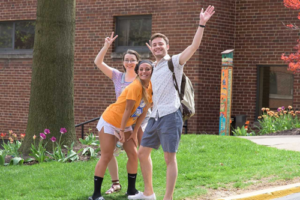As the newly appointed assistant provost for academic operations, I was brought back to Carlow University in Pennsylvania to solve basic problems and reorganize the way we operate. Specifically, I was tasked to look at the student onboarding experience and the student transition from admittance to attendance.
What made me uniquely qualified for the role of assistant provost, which includes overseeing the Student Hub (financial aid, student accounts, and registrar), was my previous experience as Carlow’s University registrar and my additional background in a large-scale student services office at West Virginia University. This afforded me the essential skills required to step into a leadership position and define the most critical needs of the student experience, which would be more challenging to someone without knowledge of Carlow’s culture and history. Even though I had an understanding of what changes had to be made, I knew that in order to make an impactful difference for our students, collaboration with other departments was vital.
Student onboarding is a collaborative process
My first task was to assess the purpose and scope of coordinator of advising position. For years, this position existed to serve, but the question as to whom it served became muddier each semester. What started as an extension of the Student Hub and an advising support for when faculty advisors were unavailable soon became a catch-all for everything advising. The coordinator’s easy accessibility caused students to circumvent their faculty advisors, creating confusion and tension. In addition, this position had no tangible jurisdiction over faculty advisors, and initiatives coming out of this office were often disregarded or not clearly articulated.
Related: How to improve faculty and staff onboarding in higher ed
On top of serving existing students, the coordinator was recruited by Enrollment Management to register new transfer students as there wasn’t a designated person to handle this task. Thus, the reporting structure became an issue given the dual focus of the position.
Redefining the advising position
The question was simple: What do we want or need from the coordinator of advising position? To address this, I convened the provost, deans, vice president of enrollment management, and other select stakeholders to discuss how to better align this position with our goal for a more structured student experience. We considered what improvements were needed and what our new and current students were lacking. From this discovery period, we deduced that the faculty advising model wasn’t broken but needed a defined direction, and that the current position caused some confusion as to how much of a role the coordinator played in the advising relationship.
What we knew conclusively was that we needed to get our new students off to a better start and set them up for success from the onset. New students were not using our technology resources, either from lack of knowledge or lack of effort. We also identified a gap in the handoff from admissions to the faculty advisor. Thus, we restructured the coordinator of advising position into what we now call the student success coordinator. This person, who reports directly to Enrollment Management, specifically serves the new student population by overseeing student registration, the introduction to Carlow’s resources, and the seamless hand-off to the student’s faculty advisor after the add/drop period.
Having a clear direction for the student success coordinator has led to increased understanding of the faculty advisor’s role, and since the students are getting off to a better start, they are more aware of the campus resources and the self-service tools at their disposal. All of which has made life a lot easier for the student and advisor.
The student success coordinator works closely with the Student Hub to ensure that students are aware of the services it offers. Students work with their faculty advisors on course selection, career advice, and other advising-specific matters but can visit the Student Hub for general assistance. If a student has an inquiry that is better addressed by an advisor, the Student Hub gives students a clear pathway and reasoning for this and will provide department chair or program director information should the advisor be unavailable.
Assessing our efforts
To evaluate the results of this position change, we contacted all new Spring 2019 students (undergraduate, graduate, and doctoral). Out of the 200+ students, we surveyed more than 27 percent and 99 percent of those we spoke with spoke positively of their onboarding experience and felt that they were well-informed of campus resources and connected to their advisor thanks to the seamless hand-off from the student success coordinator. We observed a dramatic decrease in students visiting the Student Hub because they were unable to connect with their advisor or were not sure where to find their advisor’s information.
Related: Addressing student success: strategies and tools
In closing, restructuring the advising position into a student success coordinator role required collaboration among several departments, high-level administrator support, and a formal assessment of the critical needs of our non-traditional incoming student population. We improved the onboarding experience to orient new students to our on-campus systems and resources, easing any discomfort they felt due to lack of knowledge or experience. We also created an environment in which we emphasized how important the connection is between new students and their advisors, setting the stage for a relationship that we recognized as key to a student’s educational experience.
- Fully Homomorphic Encryption can revolutionize education - April 29, 2024
- Survey: More students want to go to graduate school - April 24, 2024
- Educause, AWS launch generative AI readiness assessment tool for higher ed - April 23, 2024

